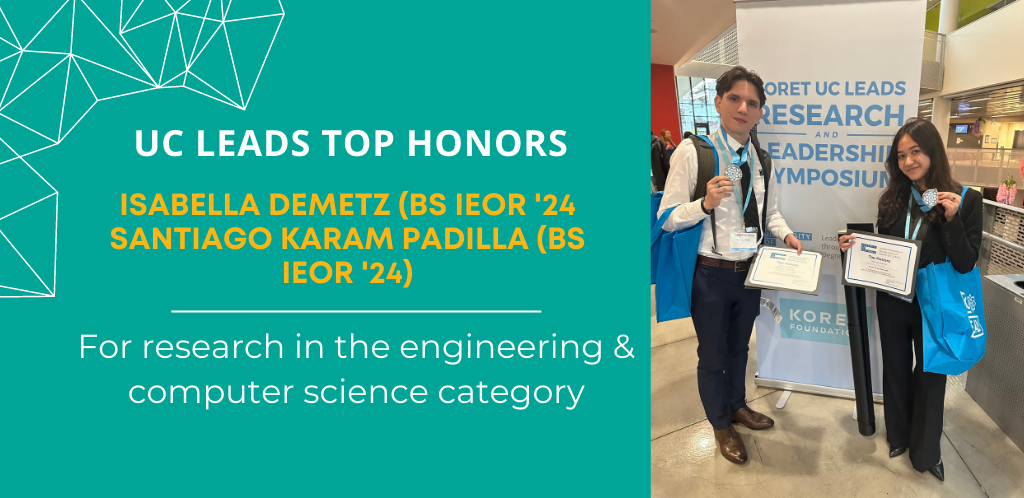Berkeley IEOR Students Receive Top Honors at UC Leads Symposium

Berkeley IEOR undergraduate students Isa Demetz and Santiago Karam Padilla won top honors for their research posters during last weekend’s UC Leads Research & Leadership Symposium. The University of California Leadership Excellence through Advanced Degrees (UC LEADS) program is designed to engage and educate California’s future leaders by preparing promising students for advanced education in science, technology, mathematics, and engineering (STEM).
Taking place in UC San Diego last weekend, the UC Leads Research & Leadership Symposium brought together student leaders from across California to present their research posters to a panel of UC alumni and faculty. Isa and Santiago both won awards for their respective research posters.
Isa Demetz presented her poster, titled “The Evaluation of Exoskeletons on Safety and Performance in Construction,” and Santiago Karam Padilla presented his poster, titled “The Effect of Integration Complexity and Strategies on the Performance of Technology-Motivated Acquisitions: An Exploratory Analysis on Frequent Acquirers from 2000-2021.” Both research posters won top honors in the Engineering and Computer Sciences category.
The abstracts for the research posters are provided below.
Title: The Evaluation of Exoskeletons on Safety and Performance in Construction
Author: Isabella Demetz
Abstract: Construction workers experience high rates of work-related musculoskeletal disorders – 11% higher than all other industry sectors in 20161,2. Passive exoskeletons in the workplace aim to reduce physical demand and augment the physical capacity of the user. We aim to understand how design differences in exoskeletons (exos) affect performance, usability, and safety in the construction industry. Participants moved through a safety obstacle course consisting of six unique activities to assess these three categories. Each subject repeated the course under six randomized test conditions (three exos in the on/off-state and a no-exo control). Motion data was captured using a full body inertial measurement system (Movella, Netherlands) and video. The differences in condition performance demonstrate that exoskeleton design characteristics have an impact on the user, as measured in errors and time. In comparing participant performance with and without exoskeletons, the difference in time and errors is most evident in tasks designed to test maneuverability. Results suggest that an exoskeleton with minimal protrusions and weight may reduce the negative unintended consequences in performance. Additional research is needed to assess impact on work specific tasks by varying levels of support, as well as to assess the suitability of exoskeletons across a variety of typical construction tasks.
Title: The Effect of Integration Complexity and Strategies on the Performance of Technology-Motivated Acquisitions: An Exploratory Analysis on Frequent Acquirers from 2000-2021.
Author: Santiago Karam Padilla
Abstract: Eager to stay ahead of fast-changing markets, technology companies have over the past 25 years made acquisitions an integral growth strategy. Yet, the desire to gain quick competitive advantage continues to often bring disappointing results owing to challenges of assimilating the entities. While a surge of research on this approach during the dotcom era of the late 1990s identified numerous success factors, we investigate how technology-driven acquisitions have evolved in the past 20 years in their integration approaches and performance. In order to understand the effect of integration complexity and strategies on the performance of technology-driven acquisitions, an exploratory, qualitative, and inductive study that aimed to identify salient variables and mechanisms was performed. A total of 83,457 technology-motivated M&A transactions were collected from the Capital IQ database and the ten largest acquisitions from the top two most frequent acquirers were selected for initial analysis, with data collected on the objectives, challenges, integration strategy, and performance for each transaction. Preliminary results indicate that under conditions of low integration complexity, integrating the target at least partially is associated with slightly or strongly positive performance. This is however unnecessary for acquisitions where the target product is standalone relative to that of the acquirer, in which case granting the target autonomy is associated with slightly or strongly positive performance. Future research will entail extending the analysis to a larger sample, followed by a systematic test of the derived model and the relationships.